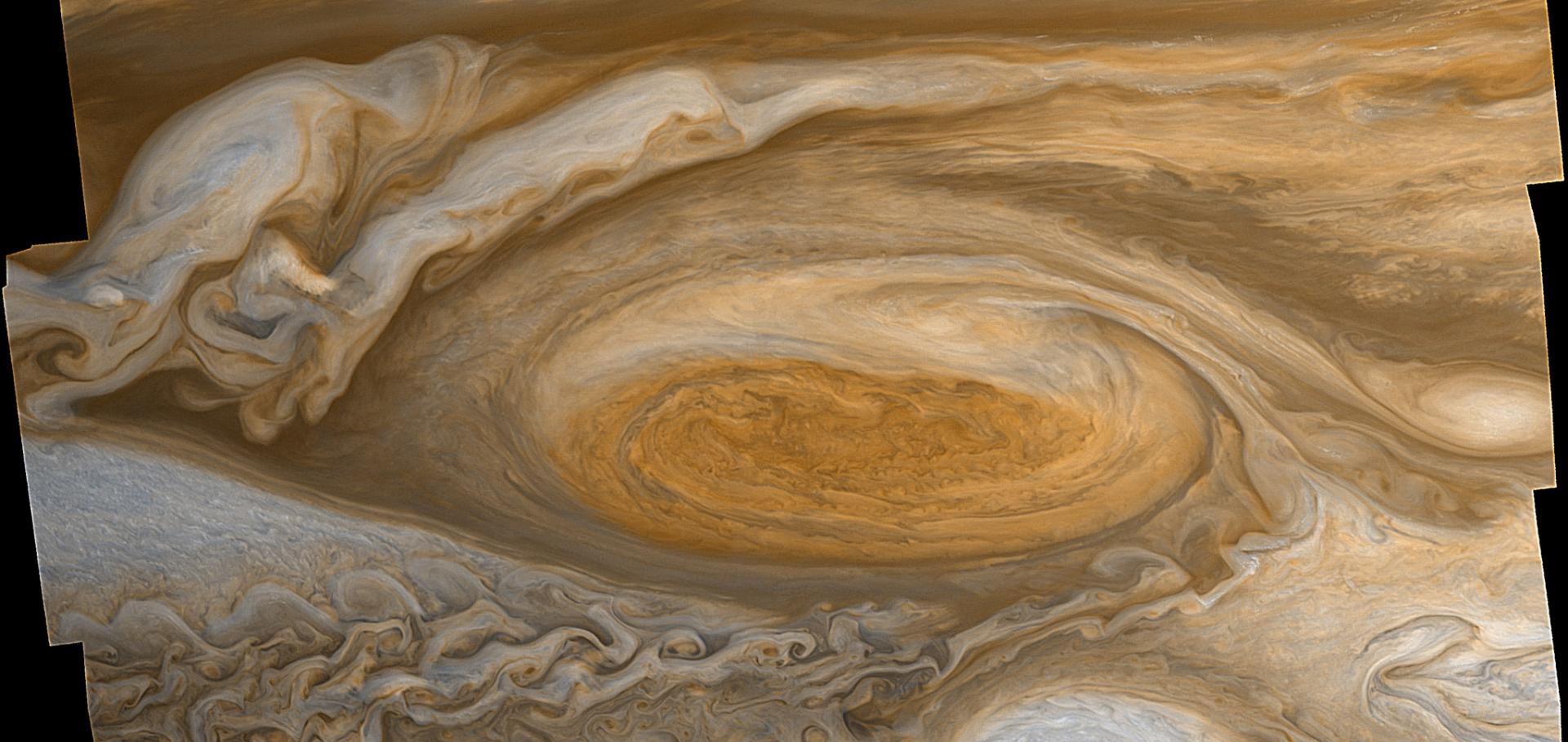Characterising turbulent cascades and zonal jet formation processes from observations of cloud level winds on Jupiter and Saturn
Abstract:
Recent analyses of wind measurements obtained from tracking cloud motions in spacecraft images of Jupiter and Saturn[1,2] indicate that nonlinear scale-to-scale transfers of kinetic energy act from small to large scales over a wide range of length scales, much as anticipated for 2D or geostrophic turbulence paradigms. At the smallest resolvable scales, however, there is evidence in observations of a forward (downscale) transfer, at least at low and middle latitudes on Jupiter, much like in the Earth’s atmosphere. Moreover, the upscale transfers at the largest spatial scales are evidently dominated by spectrally non-local, highly anisotropic eddy-zonal interactions associated with the generation of intense zonal jets and equatorial super-rotation by direct eddy-zonal flow exchanges. Most analyses to date have emphasised the global mean interactions for both planets, thereby focusing on the spatially homogeneous and isotropic components of the turbulence. Here we present some new analyses of spectral energy transfers on both Jupiter and Saturn that resolve variations in latitude[cf 3], thereby shedding new light on non-homogeneous aspects of jovian turbulent interactions. The results indicate significant variability and inhomogeneity between different locations, with a clear distinction between the tropics, the extratropical middle latitudes and the polar regions. We discuss these in light of other observations and models of gas giant circulation and related laboratory experimental analogues.[1] Antu˜nano, A., del Río-Gaztelurrutia, T., Sánchez-Lavega, A., & Hueso, R. (2015) Dynamics of Saturn’s polar regions. J. Geophys. Res.: Planets, 120 , 155–176. doi:10.1002/2014JE004709[2] Read, P. L., Antu˜nano, A., Cabanes, S., Colyer, G., del Río-Gaztelurrutia, T., Sánchez-Lavega, A. (2022). Energy exchanges in Saturn’s polar regions fromCassini observations: Eddy-zonal flow interactions. J. Geophys. Res., 127 , e2021JE006973. https://doi.org/10.1029/2021JE006973[3] Chemke, R., & Kaspi, Y. (2015). The latitudinal dependence of atmospheric jet scales and macroturbulent energy cascades. J. Atmos. Sci., 72 , 3891–3907. doi: 10.1175/JAS-D-15-0007.MACDA2: A new reanalysis for the Martian atmosphere with vertically resolved dust
Abstract:
Recent studies of the climate and weather on Mars have benefitted greatly from the development of publicly available “reanalysis” datasets. These are quantitative reconstructions of the three-dimensional, multivariate, time-varying state of the Martian atmosphere, obtained by combining observations of atmospheric variables, usually from remote sensing platforms in orbit around the planet, with a numerical model simulation of the entire atmospheric circulation and surface, using a statistical-dynamical algorithm known as an “assimilation”. The result represents an estimate of the evolving state of the entire global weather and climate that makes optimal use of both direct observations and physical knowledge of the physics and chemistry of the atmosphere and surface (as contained in the design of the numerical model), taking into account statistical uncertainties in both measurements and model simulations. This approach thereby takes account of measurement uncertainty, the incomplete coverage of observations in both space and time and enables the estimation of variables that cannot be measured directly through the internal dynamical consistency of the numerical model. At least four such datasets have been produced during the past decade or so [1-6], based on recent spacecraft observations from the Thermal Emission Spectrometer (TES) on NASA’s Mars Global Surveyor (MGS), the Mars Climate Sounder (MCS) instrument on NASA’s Mars Reconnaissance Orbiter (MRO), the Atmospheric Chemistry Suite thermal infrared channel (ACS-TIRVIM) on ESA's Trace Gas Orbiter and the Emirates Mars InfraRed Spectrometer (EMIRS) on the Emirates Mars Mission (EMM), using different assimilation algorithms. In most cases so far, the data assimilated has been limited to retrieved surface temperature and atmospheric temperature profiles, together with column integrated dust opacities (CIDO) and certain other trace gases. Although this leads to reasonable agreement between different assimilations and with independent, out of sample measurements, the neglect of measurements of the vertical structure of atmospheric dust loading leads to significant errors in modelled radiative heating and cooling rates that temperature assimilation is then required to correct. Such a correction is highly undesirable, quite apart from misrepresenting the structure and transport of dust aerosol by the circulation, and increases the likelihood of systematic errors in the reconstructed circulation. In recent work [4], the Analysis Correction system used for the Mars Analysis Correction Assimilation (MACDA) reanalysis [1] has been extended to enable the assimilation of both CIDO and profiles of dust opacity obtained from limb-sounding instruments such as MCS. The results have enabled phenomena such as the climatological elevated dust layers during northern hemisphere summer to be captured in a reanalysis (see Fig. 1), which has been elusive in previous work. In new work presented here, this approach has now been applied to more than 12 Mars years of observations, from early MY24 to the beginning of MY36 (to date), based mainly on retrievals of temperature and dust opacity from the MGS/TES and MRO/MCS instruments that have been assimilated into the UK version of the LMD Mars Planetary Climate Model. This dataset will shortly be available publicly via the UK Centre for Environmental Data Analysis (https://www.ceda.ac.uk/). Here we present an overview of the new reanalysis and illustrate some of its results with the aim of alerting researchers to this new resource for future studies. PLR and AV acknowledge support from the UK Space Agency. The authors are grateful to Armin Kleinböhl and the MCS science team for advice and early access to retrieved data.Figure 1: Snapshots of the zonally averaged structure of the Martian atmosphere during northern late summer in Mars Year 28, showing the zonal and vertical wind, temperature and dust distribution, showing the presence of a persistent elevated dust layer from the MACDA2 reanalysis.[1] Montabone, L., Marsh, K., Lewis, S. R., Read, P. L., Smith, M. D., Holmes, J., et al. (2014). The Mars Analysis Correction Data Assimilation (MACDA) dataset V1.0. Geoscience Data Journal, 1(2), 129–139. https://doi.org/10.1002/gdj3.13[2] Greybush, S. J., Kalnay, E., Wilson, R. J., Hoffman, R. N., Nehrkorn, T., Leidner, M., et al. (2019). The Ensemble Mars Atmosphere Reanalysis System (EMARS) version 1.0. Geoscience Data Journal, 6(2), 137–150. https://doi.org/10.1002/gdj3.77[3] Holmes, J. A., Lewis, S. R., & Patel, M. R. (2020). OpenMARS: A global record of Martian weather from 1999 to 2015. Planetary and Space Science, 188, 104962. https://doi.org/10.1016/j.pss.2020.104962[4] Ruan, T., Young, R. M. B., Lewis, S. R., Montabone, L., Valeanu, A., & Read, P. L. (2021). Assimilation of both column- and layer-integrated dust opacity observations in the Martian atmosphere. Earth and Space Science, 8(12), e2021EA001869. https://doi.org/10.1029/2021EA001869[5] Young, R. M. B., Millour, E., Guerlet, S., Forget, F., Ignatiev, N., Grigoriev, A. V., et al. (2022). Assimilation of temperatures and column dust opacities measured by ExoMars TGO-ACS-TIRVIM during the MY34 Global Dust Storm. Journal of Geophysical Research: Planets, 127, e2022JE007312. https://doi.org/10.1029/2022JE007312[6] Young, R. M. B., Millour, E., Forget, F., Smith, M. D., Aljaberi, M., Edwards, C. S., et al. (2022). First assimilation of atmospheric temperatures from the Emirates Mars InfraRed Spectrometer. Geophysical Research Letters, 49, e2022GL099656.The Role of Bottom Thermal Forcing on Modulating Baroclinic Instability in a Jupiter GCM
Abstract:
The atmospheric circulation of Jupiter is shaped by a complex interplay between deep internal processes and cloud-level dynamics. Numerical simulations and observational analyses have suggested that Jupiter’s mid-latitude jets are strongly influenced by baroclinic instability [1], which is governed by the planet’s atmospheric thermal structure. Jupiter emits a substantial intrinsic heat flux originating from its interior. Past modelling efforts [2, 3] have demonstrated that this internal energy plays a key role in shaping large-scale atmospheric dynamics.Our previous work [4] showed that latitudinal variations in interior heat flux can significantly impact the structure and behaviour of Jupiter’s mid-latitude jets in a General Circulation Model (GCM). Such an impact is best illustrated by the relative vorticity snapshots from two simulations with the lowest and highest latitudinal flux gradient (see Figure 1). In this study, we present a more detailed analysis linking these jet modifications to changes in the atmospheric thermal structure and, consequently, to the strength and distribution of baroclinic eddy activity. In particular, we use the Lorenz energy cycle framework to diagnose how variations in deep thermal forcing influence baroclinic energy conversion and eddy-mean flow interactions. We further examine the implications for meridional transport and the water cycle within Jupiter’s weather layer.Additionally, we present a control simulation in which the potential temperature at the model’s lower boundary is forced toward a fixed value (a deep adiabat setup). We compute the equivalent upward heat flux associated with this forcing to place it in the context of previous models that impose constant or latitudinally varying interior heat flux. This allows a direct comparison of how different representations of deep thermal forcing affect upper-atmospheric dynamics.Finally, we discuss the broader implications of these findings for future weather-layer models of Jupiter and other gas giant planets, especially on the effect of bottom boundary conditions in representing the coupling between deep and observable atmospheric dynamics. Figure 1: Mollweide projection of the relative vorticity at 1 bar at the end of two simulations.Reference:[1] Read, P. L. (2023). The dynamics of Jupiter’s and Saturn’s weather layers: a synthesis after Cassini and Juno. Annual Review of Fluid Mechanics, 56(1), 271–293. https://doi.org/10.1146/annurev-fluid-121021-040058[2] Liu, J., & Schneider, T. (2011). Convective Generation of Equatorial Superrotation in Planetary Atmospheres. Journal of the Atmospheric Sciences, 68(11), 2742-2756. https://doi.org/10.1175/JAS-D-10-05013.1[3] Young, R. M. B., Read, P. L., & Wang, Y. (2018). Simulating Jupiter’s weather layer. Part I: Jet spin-up in a dry atmosphere. Icarus, 326, 225–252. https://doi.org/10.1016/j.icarus.2018.12.005[4] Hu, X. and Read, P.: Latitudinal Variation in Internal Heat Flux in Jupiter's Atmosphere: Effect on Weather Layer Dynamics, Europlanet Science Congress 2024, EPSC2024-669, https://doi.org/10.5194/epsc2024-669, 2024.Energetic constraints on baroclinic eddy heat transport with a beta effect in the laboratory
Abstract:
Hypotheses involving energetic constraints and the down-gradient diffusion of heat in eddy parameterization theories are tested by estimating baroclinic eddy transports in rotating annulus laboratory experiments. Particle Imaging Velocimetry measurements are supplemented by numerical simulations to estimate variables not measured directly. The results with a topographic beta effect broadly support Fick's first law, and are consistent with the GEOMETRIC framework in which eddy buoyancy flux is constrained by total eddy energy. With the topographic beta effect, a relatively simple relation is observed between the eddy buoyancy flux and the total eddy energy, with the ratio quantifying the eddy transport efficiency. This efficiency decreases in more complex flow regimes with larger rotation rates, associated with the changing energy partition between eddy available potential energy and eddy kinetic energy. In the absence of a topographic beta effect, more complicated dependencies are found, suggesting roles for other variables.


